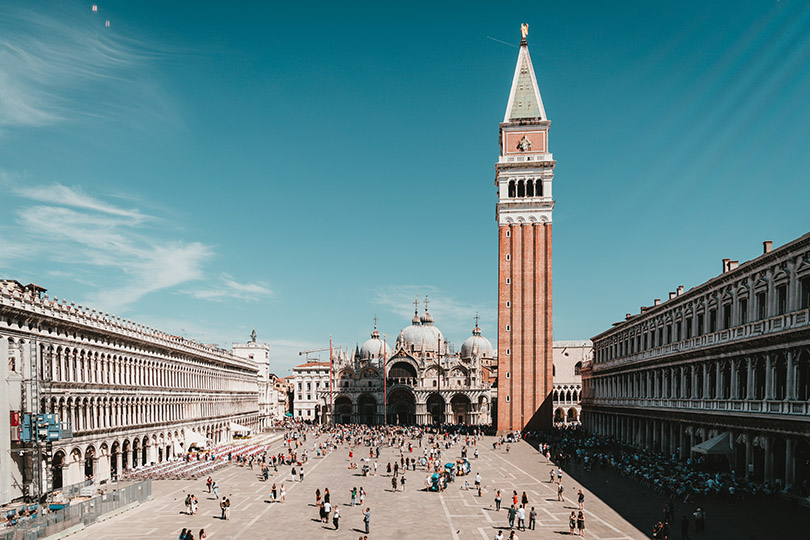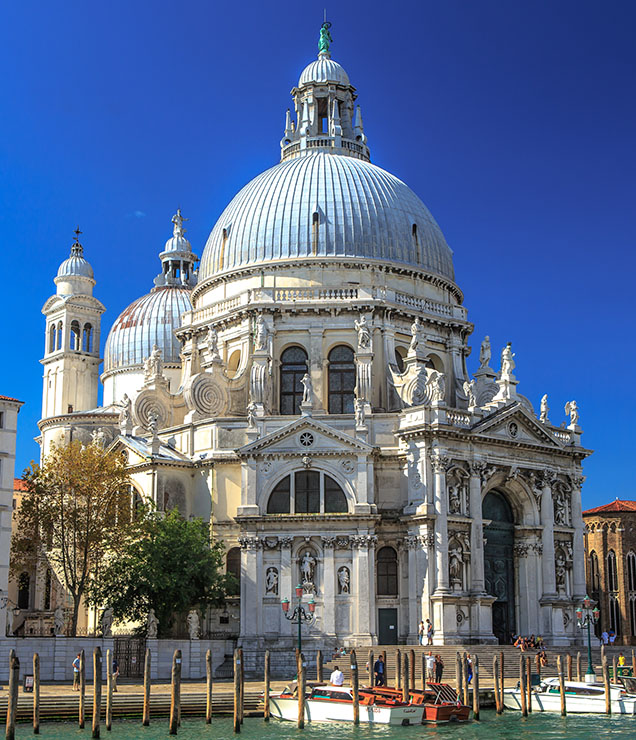
St. Mark’s Square began taking form in the 11th century; credit Claudio Schwarz
Venice History
At its earlier known inhabitation by humans, Venice was settled by an Indo-European tribe who migrated here about 1000 BC.
In 568 AD, when the fierce Germanic Lombards invaded what later became the northern mainland of Italy, one of the first cities in their path is the Christian town of Aquileia. Many of its inhabitants, fled southwards to a low-lying offshore island, Torcello. Those refugees became the widely recognized settlers of Venice. Legend says it was founded by St Mark.
Around 584 AD, parts of the east Italian coast in Byzantine hands grouped together as a defensive arrangement against the Lombards. The islanders of Torcello were included in the defense. But with the northern mainland in Lombardian hands, survival forced those settlers to become increasingly independent.
Centuries passed, then the independent sect came to think of themselves as Venetians. In 726, they first elected their own doge (the equivalent of ‘duke’, from the Latin dux meaning ‘leader’). Thus, Orso became the first Venetian doge to come to power specifically to oppose Byzantine rule over the islands of the lagoon. But Byzantine officials led many battles that held the islands until 751. Over time the Venetians develop specialized skills in trading goods.
Then in 809, the son of Charlemagne campaigned in northern Italy, and the Venetian doge, seeing Franks as a more powerful force, wisely makes an alliance with him without appearing too close. This risky move allows Venice to play the Franks and Byzantines off against each other while Venice thrives.
When the treaty in 814 was signed between the Franks and Byzantines, the city remains independent with no special obligation to Constantinople. Perfectly placed between the Mediterranean, the mountain passes up to northern Europe and Eastern Europe, Venice is poised to make her fortune as the premier trading post of Europe.
Early in the 9th century, the government of the lagoon is transferred to two adjacent islands where the land is a little higher above sea level, whereas in Venice every inch matters.
To either side of the waterway is a rivo alto (‘high bank’), from which the name Rialto derives. The Rialto Bridge joins these two banks. Then the city acquires from Alexandria, Egypt some relics of the patron saint St Mark to increase its cultural status. With that acquisition 828 Venice comes of age. A church to house the relics was built and rebuilt in the 11th century.
With various modifications over the centuries, the church in St. Marks Square remains the centerpiece of the city.

Santa Maria della Salute Basilica on the Grand Canal; credit fou’12
The Normans drive the Byzantines from their last seaport in southern Italy by 1071, and soon they begin raiding across the Adriatic Sea. In return for help against the marauders, the Byzantine emperor grants Venice the right to trade freely throughout the Byzantine Empire without tariffs.
A great increase in trade and pilgrimage travel to the eastern Mediterranean resulted in Venice as the strongest beneficiary. Venetian merchants become known for their travel far and wide across the Mediterranean making trade agreements. They avoided wars as much as possible.
St. Mark’s craftsmen produce probably the most sumptuous church interior in the world, with every corner a sombre glittering gold and Italian mosaics that represent the culmination of a great Byzantine tradition.
In addition to its Byzantine mosaics, St. Mark’s Square contains in the Pala d’Oro the most spectacular surviving altarpiece from Byzantine churches with scenes of Jesus, the Virgin, and saints set in a gold background encrusted with jewels.
In 1380, Venice finally defeats Genoa and becomes the undisputed maritime power in the region. Corfu is recovered in 1401. The Croatian coast is ceded to Venice in 1420. Zante is acquired in 1482.
Finally, Cyprus, the jewel at the end of the chain, is annexed in 1489. For the next two centuries, the Venetians battle the Turks as their expanding empires collide. None seem to gain a decisive advantage.
Early in the 1500s, Italy becomes the prime battleground of warfare between Venice, France, and Spain, even as the latter two nations explore the New World. A series of shifting alliances, often brokered by the papacy redraws the map of Italy. The territories and influence of Milan, Venice, Naples, and Rome shift in often unpleasant ways.
With the emergence of England, Spain, France, and the Dutch from their New World slave-produced wealth, Venice, which was not a player in the Trans-Atlantic slave trade, enters a long and gradual period of decline. Venice could only defend its Mediterranean possessions from the Turks.
In the long run, even this proves a hopeless battle.
A century later, in 1669, the Turks finally evict the Venetians from Crete. Losing its political will to fight, Venice finds consolement by redefining itself as one of Europe’s favored tourist destinations.
It opens the first public opera house in 1637 and starts the tradition of the pageantry masked women who delight wealthy traveling men.
This city marketed visits to the European upper crust until Napoleon intruded in 1797. Campaigning against Austria in Italy then, Napoleon deposed the last doge. By the treaty of Campo Formio, Venice is handed over to Austria and remained under Austrian rule until 1866.
Venice and the Veneto (Venetia) are ceded to the newly independent kingdom of Italy. The ancient city as it remains today, the capital of Venezia province. Today, African American travelers are likely to encounter small numbers of African visitors, more than native Afro-Europeans or ex-pat African Americans. Its still all good to visit.
